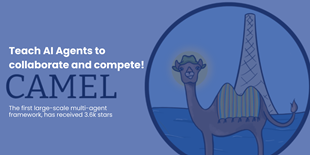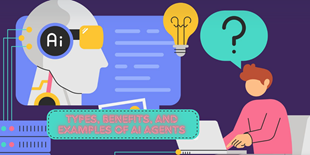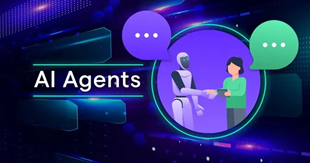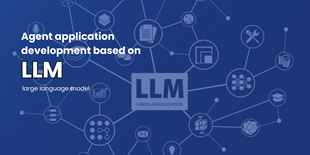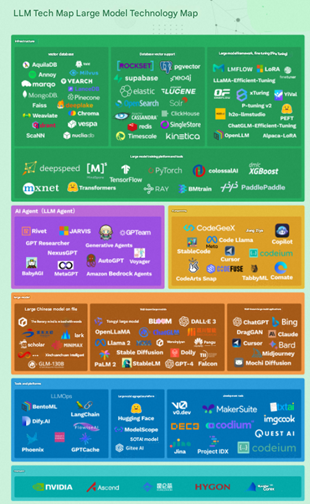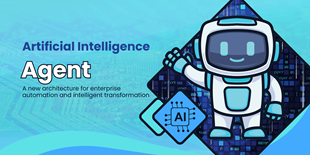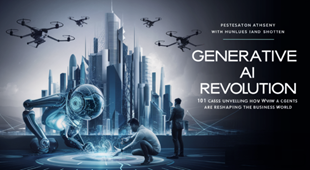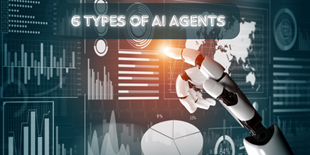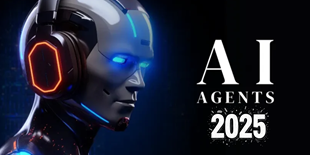Types, benefits, and examples of AI agents
AI agents are a key technological advancement that is reshaping business dynamics. Learn how these agents operate and discover their key benefits including efficiency, scalability, and cost-effectiveness. We will explore real-world examples of agents and their applications in various fields, paving the way for future AI trends and their impact on customer experience.
Imagine a team of invisible digital strategists constantly analyzing data, customizing customer interactions, and driving business into a new era of efficiency. This is not the plot of a futuristic novel, but the reality of AI agents in today's business world. Far from being fictional conscious machines, agents are practical and powerful tools that are revolutionizing the way companies operate.
These agents not only automate tasks, they redefine the approach to business challenges. They are silent partners in decision making, providing insights that reshape industries and customer experiences. This article aims to explain agents, go beyond the buzzwords and reveal how they can transform your business. From streamlining processes to enhancing customer interactions, agents are the new frontier for business intelligence and innovation.
1. What is an AI agent?
In artificial intelligence, an agent is a computer program or system. Fundamentally, an AI agent is a computer program that is able to make decisions based on its environment, inputs, and predefined goals, autonomously performing tasks to achieve a specific goal or set of goals. The agent operates autonomously, which means it is not under the direct control of human operators.
Agents can be divided into different types based on their characteristics, such as whether they are passive or active, whether they have a fixed or dynamic environment, and whether they are single-agent or multi-agent systems.
Reflective agents are those that react to immediate stimuli in their environment and act based on those stimuli. Proactive agents, on the other hand, take initiative and plan ahead to achieve their goals. The environment in which an agent operates can also be fixed or dynamic. Fixed environments have a static set of rules that do not change, while dynamic environments are constantly changing, requiring the agent to adapt to new situations.
Multi-agent systems involve multiple agents working together to achieve a common goal. These agents may have to coordinate their actions and communicate with each other to achieve their goals. Agents are used in a variety of applications, including robotics, games, and intelligent systems. They can be implemented using different programming languages and techniques, including machine learning and natural language processing.
Artificial intelligence is defined as the study of rational agents. A rational agent can be anything that makes decisions, such as a person, company, machine, or software. It takes actions with the best outcome after considering past and current perceptions (the agent's perceived input in a particular situation). An AI system consists of an agent and its environment . An agent acts in its environment. The environment may contain other agents.
An agent can be thought of as:
- Sense the surrounding environment through sensors
- Operate the environment through actuators
Note : Every agent can perceive its own actions (but not always effects).

3. Structure of AI Agents
To understand the structure of intelligent agents, we should be familiar with architectures and agents . The architectureis the machine on which the agent executes. It is a device with sensors and actuators, such as a robot car, camera, and PC. The agent is the implementation of the agent function. The agent function is a mapping from a perception sequence (the history of everything the agent has perceived so far) to actions.
Agent = Architecture + Agent Program
There are many examples of agents in artificial intelligence. Here are some:
- Intelligent personal assistants: These are agents designed to help users complete various tasks, such as scheduling appointments, sending messages, and setting reminders. Examples of intelligent personal assistants include Siri, Alexa, and Google Assistant
- Autonomous robots: These are agents designed to operate autonomously in the physical world. They can perform tasks such as cleaning, sorting, and delivering goods. Examples of autonomous robots include Roomba vacuum cleaners and Amazon delivery robots.
- Gaming agents: These agents are designed to play games, either against human opponents or other agents. Examples of gaming agents include chess playing agents and poker playing agents.
- Fraud detection agents: These agents are designed to detect fraud in financial transactions. They can analyze behavioral patterns to identify suspicious activity and alert authorities. Examples of fraud detection agents include those used by banks and credit card companies.
- Traffic Management Agents: These agents are designed to manage the flow of traffic in a city. They can monitor traffic patterns, adjust traffic lights, and reroute vehicles to minimize congestion. Examples of traffic management agents include those used in smart cities around the world.
- Software Agent: Has key presses, file contents, receives network packets as a sensor and displays on the screen, files and sends network packets as an actuator.
- Human agents : have eyes, ears, and other organs as sensors, and hands, legs, mouths, and other body parts as actuators.
- Robotic Agent: Has a camera and infrared rangefinder acting as sensors and various motors acting as actuators.

4. AI Agent Types
Agents can be divided into six categories based on their degree of perceived intelligence and capabilities:
- Simple reflection proxy
- Model-based reflective proxy
- Target-based proxy
- Utility-based agents
- Learning Agent
- Hierarchical Proxy
4.1 Simple Reflection Proxy
Simple reflective agents ignore the rest of the perception history and act only based on the current perception . The perception history is the history of everything the agent has perceived so far. Agent functionality is based on condition-action rules . Condition-action rules are rules that map states (i.e. conditions) to actions. If the condition is true, the action is performed, otherwise it is not. This agent functionality will succeed only if the environment is fully observable. Infinite loops are usually unavoidable for simple reflective agents operating in partially observable environments. If the agent can randomize its behavior, it may be possible to get out of infinite loops. Simple Reflective Agent

4.1.1 Principle
Simple reflex agents perform their functions by following conditional,action rules, which specify the actions to be taken under certain conditions.
4.1.2 Examples
A rule-based system for implementing intelligent customer service. If a customer's message contains the keyword "password reset", the system can automatically generate a predefined response containing instructions on resetting the password.
4.1.3 Advantages
- Simplicity: Easy to design and implement, requires few computing resources, and does not require extensive training or complex hardware.
- Implementation: Ability to respond to environmental changes in real time.
- High reliability: High reliability when the sensors providing the input are accurate and the rules are well designed.
4.1.4 Weakness
- Intelligence is very limited. Prone to error if input sensors are faulty or rules are poorly designed.
- There is no memory or state, no knowledge of the non-perceiving part of the state.
- Limited to a specific set of operations and unable to adapt to new situations.
- It cannot handle changes in the environment that were not explicitly programmed, and requires updating the rule set if any changes occur in the environment.
4.2 Model-based Reflective Proxy
It works by finding a rule that matches the current situation. Model-based agents can use a model about the world to handle partially observable environments . The agent must keep track of an internal state that is adjusted by each perception , and this state depends on the perception history. The current state is stored inside the agent, and the agent maintains some structure to describe the parts of the world that it cannot see.
The following information is required to update the status:
- How does the world evolve independently of agents?
- How do the actions of agents affect the world?

4.2.1 Principle
Model-based agents follow condition+action rules that specify the appropriate action to take in a given situation. But unlike simple reflexive agents, model-based agents also use their internal state to evaluate conditions during decision and action processes.
The model-based agent operates in four phases:
- Perception: It senses the current state of the world through sensors.
- Model: It builds an internal model of the world based on what it sees.
- Reasoning: It uses its own model of the world to decide how to act based on a set of predefined rules or regulations.
- Behavior: The agent performs its chosen behavior.
4.2.2 Examples
- One of the best examples of a model-based agent is Amazon Bedrock, a service that uses underlying models to simulate operations, gain insights, and make informed decisions for effective planning and optimization.
- Through various models Bedrock can gain insights, predict outcomes and make informed decisions. It continuously improves its models using real data, allowing it to adapt and optimize its operations.
- Amazon Bedrock then plans for different scenarios and selects the best strategy by simulating and tuning model parameters.
4.2.3 Advantages
- Make fast and effective decisions based on your understanding of the world.
- Better able to make accurate decisions by building an internal model of the world.
- Adapt to environmental changes by updating internal models.
- By using its internal state and rules to determine the condition.
4.2.4 Weakness
- The computational cost of building and maintaining models can be high.
- These models may not capture the complexity of real-world environments well.
- Models cannot predict all potential situations that may arise.
- Models need to be updated frequently to stay current.
- Models may have challenges in terms of understanding and interpretability.
4.3 Goal-based Agents
These types of agents make decisions based on how far they are currently from a goal (a description of an ideal situation). Each of their actions is intended to shorten their distance to the goal. This allows the agent to choose among multiple possibilities, selecting the one that reaches the goal state. The knowledge that supports their decisions is explicitly represented and can be modified, which makes these agents more flexible. They usually require search and planning. The behavior of goal-based agents can be easily changed.
These agents are also called rule-based agents because they follow predefined rules to achieve goals and take specific actions based on certain conditions.
Goal-based agents are easy to design and can handle complex tasks. They can be used in various applications such as robotics, computer vision, and natural language processing.
Unlike basic models, goal-based agents can determine the best path for decision-making and action courses based on their desired outcomes or goals.

4.3.1 Principle
Given a plan, a goal-based agent attempts to select the best strategy to achieve the goal and then uses a search algorithm to find an efficient path to the goal.
The working mode of goal-based proxy can be divided into five steps:
- Perception : An agent perceives its environment using sensors or other input devices to gather information about its surroundings.
- Reasoning : The agent analyzes the information it collects and decides on the best course of action to achieve its goal.
- Action : The agent takes actions to achieve its goals, such as moving or manipulating objects in the environment.
- Evaluation : After taking an action, the agent evaluates its progress toward its goal and adjusts its actions if necessary.
- Goal Completion : Once the agent achieves its goal, it either stops working or starts working on a new goal.
4.3.2 Examples
[Google Bard]( https://blog.google/technology/ai/bard-google-ai-search-updates/ ) is also a goal-based agent in a sense. As a goal-based agent, its goal is to provide high-quality responses to user queries. The actions it chooses are likely to help users find the information they need and achieve their intended goal of getting accurate and useful responses.
4.3.3 Advantages
- Easy to understand and implement.
- Effectively achieve specific goals.
- Easy to evaluate performance against goal achievement.
- It can be combined with other AI techniques to create more advanced agents.
- Ideal for well-defined, structured environments.
- Can be used in various applications such as: robotics, gaming and self-driving cars.
4.3.4 Weakness
- Limited to specific goals.
- Unable to adapt to changing circumstances.
- Not effective for complex tasks with too many variables.
- Extensive domain knowledge is required to define the goals.
4.4 Utility-based Agents
Agents developed with end-use as building blocks are called utility-based agents. Utility-based agents are used when there are multiple possible alternatives, in order to decide which one is best. They choose actions based on their preferences (utility) for each state . Sometimes, achieving the desired goal is not enough. We may want to reach the destination faster, safer, cheaper. The happiness of the agent should be taken into account. Utility describes how "happy" the agent is. Due to the uncertainty of the world, utility agents choose actions that maximize the expected utility. The utility function maps states to real numbers that describe the associated happiness.

4.4.1 Principle
- A utility-based agent aims to choose actions that lead to high-utility states. To achieve this, it needs to model its environment, which can be simple or complex.
- Then, the expected utility of each possible outcome is evaluated based on the probability distribution and the utility function.
- Finally, the action with the highest expected utility is chosen and this process is repeated at each time step.
4.4.2 Examples
- Anthropic Claudeis an AI tool whose goal is to help cardholders maximize the rewards they get from using their cards and is a utility-based agent.
- To achieve its goal, it uses a utility function that assigns numerical values representing success or happiness to different states (situations faced by the cardholder, such as: making a purchase, paying a bill, redeeming a reward, etc.) It then compares the results of different actions in each state and weighs the decisions based on their utility values.
- Additionally, it uses heuristics and artificial intelligence techniques to simplify and improve decision making.
4.4.3 Advantages
- Can handle a wide range of decision-making problems
- Learn from experience and adjust their decision-making strategies
- Provide a unified and objective framework for decision-making applications
4.4.4 Weakness
- An accurate model of the environment is required, otherwise it will lead to wrong decisions
- High computational cost, requiring a lot of calculations
- No consideration of moral or ethical factors
- It is difficult for humans to understand and verify its process
4.5 Learning Agent
A learning agent in artificial intelligence is an agent that is able to learn from past experiences or has the ability to learn. It starts with basic knowledge and then is able to act and adapt automatically through learning. There are four main conceptual components of a learning agent, namely:
- Learning element: Responsible for making improvements by learning from the environment.
- Critic:The learning element receives feedback from the critic that describes how well the agent performs with respect to a fixed performance criterion.
- Performance element: responsible for selecting external actions.
- Question Generator: This component is responsible for suggesting actions that lead to novel and rewarding experiences.

4.5.1 Principle
AI learning agents follow a closed loop of observation, learning, and action based on feedback. They interact with the environment, learn from feedback, and modify their behavior for future interactions.
Here’s how this closed loop works:
- Observation : The learning agent observes its environment through sensors or other inputs.
- Learning : The agent analyzes data using algorithms and statistical models to learn from feedback on its behavior and performance.
- Action : Based on what it has learned, the agent takes actions in its environment to decide how to act.
- Feedback : The agent receives feedback about its behavior and performance through rewards, penalties, or environmental cues.
- Adaptation : Using feedback, the agent changes its behavior and decision-making process, updates its knowledge and adapts to its environment.
- This cyclical process repeats over time, enabling the agent to continuously improve its performance and adapt to changing circumstances.
4.5.2 Examples
AutoGPT is a great example of a learning agent, let’s say you want to buy a smartphone. So, you give AutoGPT a prompt to do a market research on the top 10 smartphones and provide insights about their pros and cons.
To complete your task, AutoGPT will analyze the pros and cons of the top 10 smartphones by exploring various websites and sources. It uses sub-agents to assess the authenticity of the websites. Finally, it generates a detailed report summarizing the findings and listing the pros and cons of the top 10 smartphone companies.
4.5.3 Advantages
- Agents can turn thoughts into actions based on AI decisions
- Learning agents can follow basic commands, such as verbal instructions, and perform tasks
- Unlike classical agents that perform predefined actions, learning agents can evolve over time.
- AI agents take utility measurements into account, making them more realistic
4.5.4 Weakness
- May lead to biased or incorrect decision making
- High development and maintenance costs
- Requires a lot of computing resources
- Reliance on large amounts of data
- Lack of human intuition and creativity
4.6 Layered Proxy
These agents are organized into a hierarchy where high-level agents supervise the behavior of lower-level agents. High-level agents provide goals and constraints, while low-level agents perform specific tasks. Hierarchical agents are very useful in complex environments with many tasks and subtasks.
- Hierarchical agents are agents organized in a hierarchy, with higher-level agents supervising the behavior of lower-level agents. Higher-level agents provide goals and constraints, while lower-level agents perform specific tasks. This structure allows for more efficient and organized decision making in complex environments.
- Hierarchical agents can be used in a variety of applications, including robotics, manufacturing, and transportation systems. They are particularly useful in environments where many tasks and subtasks need to be coordinated and prioritized.
- In a hierarchical agent system, high-level agents are responsible for setting goals and constraints for lower-level agents. These goals and constraints are usually based on the overall goal of the system. For example, in a manufacturing system, a high-level agent might set production goals for lower-level agents based on customer demand.
- Low-level agents are responsible for performing specific tasks to achieve the goals set by high-level agents. These tasks can be relatively simple or more complex, depending on the specific application. For example, in a traffic system, a low-level agent might be responsible for managing traffic flow at a specific intersection.
- Depending on the complexity of the system, hierarchical agents can be organized into different levels. In a simple system, there may be only two levels: high-level agents and low-level agents. In more complex systems, there may be multiple levels, with intermediate-level agents responsible for coordinating the activities of lower-level agents.
- One advantage of hierarchical agents is that they make more efficient use of resources. By organizing agents into a hierarchy, tasks can be assigned to the agent best suited to perform them while avoiding duplication of effort. This enables faster, more efficient decision making and improves the overall performance of the system.
A hierarchical proxy is a hierarchical structure that can contain high-level agents and low-level agents, with high-level agents supervising low-level agents. However, these levels may vary depending on the complexity of the system.
Application scenarios of hierarchical agents include: robotics, manufacturing, transportation, etc. It is good at coordination, handling multitasking and subtasks.
4.6.1 Principle
Hierarchical agents work like a company’s organization. They organize tasks in a structured hierarchy consisting of different levels, where higher-level agents oversee and break down goals into smaller tasks.
Lower-level agents then perform these tasks and provide progress reports.
In case of complex systems, there may be intermediate level agents that coordinate the activities of lower level agents with higher level agents.
4.6.2 Examples
Google’s UniPi is an innovative AI hierarchical agent that uses text and video as a universal interface, enabling it to learn a variety of tasks in a variety of environments.
UniPi consists of a high-level policy that generates instructions and demonstrations and a low-level policy that executes tasks. The high-level policy adapts to various environments and tasks, while the low-level policy learns through imitation and reinforcement learning.
This hierarchical structure enables UniPi to effectively combine high-level reasoning and low-level execution.
4.6.3 Advantages
- Hierarchical agents provide resource efficiency by assigning tasks to the most appropriate agent and avoiding duplication of work.
- Hierarchical structures enhance communication by establishing clear lines of authority and direction.
- Hierarchical reinforcement learning (HRL) improves agent decision making by reducing action complexity and enhancing exploration. It adopts high-level operations to simplify the problem and facilitate agent learning.
- Hierarchical decomposition provides the benefit of minimizing computational complexity by providing a more concise and reusable representation of the entire problem.
4.6.4 Weakness
- Complexity arises when using hierarchies to solve problems.
- Fixed hierarchies limit adaptability in changing or uncertain environments, hindering the agent’s ability to adjust or find alternatives.
- Hierarchical agents follow a top-down control flow, which can cause bottlenecks and delays even when lower-level tasks are ready.
- Hierarchies may lack reusability across different problem domains, requiring the creation of new hierarchies for each domain, which is time consuming and dependent on expertise.
- Training hierarchical agents is challenging due to the need for labeled training data and elaborate algorithmic design. Applying standard machine learning techniques to improve performance is even more difficult due to their complexity.
Overall, hierarchical agents are a powerful tool in artificial intelligence that can help solve complex problems and improve efficiency in a variety of applications.
5. Multi-agent system
These agents interact with other agents to achieve a common goal. They may have to coordinate their actions and communicate with each other to achieve their goals.
A multi-agent system (MAS) is a system consisting of multiple interacting agents designed to work together to achieve a common goal. These agents may be autonomous or semi-autonomous and are able to perceive their environment, make decisions, and take actions to achieve a common goal.
MAS can be used in a variety of applications, including transportation systems, robotics, and social networks. They can help improve efficiency, reduce costs, and increase the flexibility of complex systems. MAS can be divided into different types based on their characteristics, such as whether the agents have the same or different goals, whether the agents cooperate or compete, and whether the agents are homogeneous or heterogeneous.
- In a homogeneous MAS, all agents have the same capabilities, goals, and behaviors.
- In contrast, in a heterogeneous MAS, agents have different capabilities, goals, and behaviors.
This can make coordination more challenging, but it can also lead to a more flexible and powerful system.
Cooperative MAS involves agents working together to achieve a common goal, while competitive MAS
involves agents working against each other to achieve their own goals. In some cases, MAS may also involve both cooperative and competitive behavior, where agents must balance their own interests with the interests of the group.
MAS can be implemented using different techniques, such as game theory , machine learning, and agent-based modeling. Game theory is used to analyze strategic interactions between agents and predict their behavior. Machine learning is used to train agents to improve their decision-making capabilities over time. Agent-based modeling is used to simulate complex systems and study the interactions between agents.
Overall, multi-agent systems are powerful tools in the field of artificial intelligence that can help solve complex problems and improve the efficiency of a wide range of applications.
6. How do AI agents work?
The workflow of an AI agent is a complex and dynamic process that combines data analysis, decision-making, and continuous learning. For businesses, understanding this workflow is critical to effectively deploying AI agents. Understanding how AI agents operate enables businesses to set appropriate goals, provide necessary resources, and effectively interpret results, whether in customer service, supply chain management, or strategic planning.
Let's take a deeper look at how AI agents work:
- Goal initialization: The first step involves setting a clear goal for the AI agent. It can be anything from analyzing market trends to automating customer support. The agent uses its core language model to interpret the goal and initiate its action plan.
- Task list creation: Based on the defined goals, the AI agent generates a list of tasks. This process includes prioritizing tasks, planning the order of execution, and preparing for unexpected events. The task list is the agent’s roadmap to achieve the set goals.
- Information gathering: To perform tasks effectively, AI agents gather relevant information. It may involve searching the internet, accessing databases, or interacting with other AI models to perform specialized tasks such as image processing or geographic data analysis. The agent’s ability to use computers like a human significantly broadens its research capabilities.
- Data Management and Strategy Improvement: As agents collect data, they continually manage and analyze this information. This data is used not only to report to the business, but also to improve its strategy. By evaluating the effectiveness of its actions, agents can adjust their approach to more effectively achieve their goals.
- Feedback Integration and Iteration: An important part of the AI agent workflow is integrating feedback. This feedback can come from external sources such as market data, customer feedback, or internal monitoring systems. The agent uses this feedback to evaluate its progress towards its goals, making necessary adjustments to its task list and approach.
- Continuous operation until goal is achieved: AI agents operate in a cycle of action, feedback, and adaptation until the set goal is achieved. This continuous operation is the hallmark of AI agents, distinguishing them from traditional software programs.
- Adaptive learning: Throughout the process, the AI agent not only performs tasks but also learns from its experience. This type of learning allows the agent to become more efficient over time and adapt to new challenges and environments.
7. Key benefits of using AI agents for businesses
Incorporating AI agents into your business operations can provide a variety of advantages that can significantly impact a company’s bottom line. AI agents are transforming business operations—from operational efficiency to enhancing customer experience. It also enhances the way businesses compete and succeed in the modern marketplace.
The following are the main advantages of using AI agents in a business setting:
7.1 Improve efficiency
AI agents excel at handling repetitive and routine tasks that traditionally consume a lot of human resources and time. It includes tasks such as data entry, scheduling, customer inquiries, and basic analysis. By automating these tasks, companies can reallocate human resources to more strategic and creative areas, thereby improving overall productivity and innovation.
7.2 Effective Personalization
One of the standout features of AI agents is their ability to provide customers with a personalized experience. AI agents can tailor recommendations, responses, and services to individual needs by analyzing customer data, preferences, and past interactions. This level of personalization not only increases customer satisfaction, but also drives customer loyalty and repeat business because customers feel understood and valued.
7.3 Seamless and Cost-Effective Scalability
AI agents are inherently scalable. They can handle an increasing number of tasks or interactions without having to scale up resources or infrastructure. This scalability is particularly beneficial during peak business periods, product launches, or market expansions, when demand for resources may increase dramatically.
7.4 Higher Availability
Unlike human employees, AI agents can work around the clock without taking breaks, fatigue, or downtime. This 24/7 availability ensures that businesses can provide continuous service, support, or monitoring, which is critical in today's fast-paced market.
The constant presence of AI agents means that customer queries can be resolved promptly at any time, thereby improving customer experience and satisfaction.
7.5 Cost Savings
Implementing AI agents can lead to significant cost savings. By reducing the need for a large workforce to manage routine tasks, businesses can save on wages, training, and related expenses. Additionally, AI agents can help optimize processes and identify efficiencies, further reducing operational costs.
7.6 Data-Driven Insights
Modern AI agents can collect and process large amounts of data efficiently. As a result, businesses using AI agents can gain valuable insights into customer behavior, market trends, and operational efficiency. These insights can help companies make smarter decisions, customize strategies, and stay ahead of the competition.
8. AI Agent Example
The world of artificial intelligence is filled with diverse and innovative examples of AI agents, each designed to achieve specific functions and solve unique challenges. Let’s explore some of these examples to understand how AI agents are making a significant impact in various fields:
8.1 Intelligent Personal Assistant
AI-powered personal assistants are becoming more common in our daily lives. Like helpful neighbors, these savvy AI-powered assistants understand our needs and respond accordingly. Think of Siri, Alexa, or Google Assistant—they’re more than software, they’re more like digital companions. They remind us of important appointments, answer our curious questions, keep our schedules on track, and even manage our smart homes. The great thing is that as we interact with them, they learn about us, and their help becomes more targeted and valuable over time.
8.2 Autonomous Robots
Our robotic assistants are real game changers when it comes to handling manual tasks. These independent machines excel in a variety of settings, doing everything from household chores to industrial heavy lifting. Think of the smart vacuum cleaners that roam around our homes, effortlessly keeping them clean. Or take a look at Amazon’s warehouses, where robots efficiently sort and transport items, streamlining the entire operation. These robots are more than just machines; they’re equipped with advanced sensors and artificial intelligence that allow them to understand their surroundings, make smart choices, and complete tasks with little to no human help.
8.3 Gambling Agent
AI agents in games have evolved from basic computer opponents to advanced entities capable of competing with or even surpassing human players. Examples include AI agents developed for chess, such as Deep Blue, and more recently AlphaGo, which made headlines for defeating the world champion in the complex game of Go. These gaming agents use deep learning and strategic analysis to make decisions, providing entertainment and a platform for AI research and development.
8.4 Fraud Detection Agent
AI agents play a vital role in detecting and preventing fraudulent activities in the financial sector. These agents analyze transaction patterns to identify anomalies that may indicate fraudulent activity. Banks and credit card companies use these AI agents to monitor account activity and flag unusual transactions for further investigation, thereby protecting customers from potential fraud. The continuous learning capabilities of these agents allow them to adapt to new fraud methods more and more effectively, providing essential security for financial operations.
9. AI Agents Across Business Units
AI agents are not limited to a single sector; their versatility enables them to bring transformational changes to various business sectors. Each sector utilizes these agents in unique ways, demonstrating
the adaptability and broad usefulness of AI technology. Here are some examples of AI agents being used in different business sectors:
9.1 Finance
In the financial sector, AI agents are revolutionizing the delivery of financial services. They are widely used for automated trading, risk assessment, fraud detection, and personalized financial advice. AI
agents analyze market trends and customer data, provide real-time insights for investment decisions, and play a key role in identifying abnormal patterns that may indicate fraudulent activity.
The application of AI agents in the financial sector can not only improve efficiency but also enhance the security and compliance of financial operations.
9.2 Electricity
AI agents bring huge advantages to the power industry in managing and optimizing energy distribution and consumption. These agents can predict demand patterns, optimize grid operations, and even detect system failures before they occur.
By analyzing data from various sensors and systems, AI agents help maintain a balance between energy supply and demand, leading to more sustainable and efficient energy management.
9.3 Transportation
AI agents contribute to smarter traffic management, route optimization, and autonomous vehicle technology. They analyze traffic data in real time to optimize traffic flow and reduce congestion. In the logistics sector, AI agents streamline supply chain operations by predicting delays, optimizing delivery routes, and managing inventory more efficiently.
9.4 Healthcare
In healthcare, AI agents can assist with patient diagnosis, treatment planning, and healthcare service management. These agents can analyze medical records and imaging data to assist with diagnosis, recommend treatment options, and even predict patient outcomes. They also enhance patient care through personalized medicine and remote monitoring systems.
9.5 Customer Service
AI agents have become an integral part of customer service, providing 24/7 support, personalized interactions, and efficient handling of inquiries and complaints. From chatbots on websites to voice assistants , AI agents handle a wide variety of customer interactions, shortening response times and increasing satisfaction while reducing the workload of human customer service representatives.
10. Future trends of AI agents
The development of AI agents continues to shape the landscape of various industries. Inspired by visionaries such as Bill Gates who foresaw that AI agents would be at the core of technological advancement, we are about to witness groundbreaking trends in this field. Let’s dive into some of these anticipated trends that will redefine the capabilities and applications of AI agents.
10.1 AI-Powered Customer Experience (CX)
The customer experience of the future will be significantly impacted by artificial intelligence. We are looking at AI agents that not only provide personalized recommendations but also provide interactive and immersive experiences with smart chatbots and virtual assistants.
These advances will enable businesses to engage with customers in more meaningful and effective ways, increasing customer satisfaction and loyalty through tailored interactions and responsive services.
10.2 Automation and Robotics
The role of AI in automation and robotics is only going to grow. AI agents are transforming traditional processes from the manufacturing floor with industrial robots to the streets with self-driving cars.
This trend means not only increased efficiency but also a reduction in human error and intervention, paving the way for safer and more reliable operations across all sectors.
10.3 Generative Artificial Intelligence
Generative AI is an exciting frontier where AI agents are not only data interpreters but also new content creators. It includes generating art, composing music, and even developing unique written content with the help of generative AI models such as GAN, RNN, and CNN.
As generative AI matures, we could see a surge in creative applications of AI that revolutionize fields such as advertising, entertainment, and media. The skill of just-in-time engineering will be critical to guiding these AI agents to produce high-quality, contextually appropriate outputs.
10.4 Artificial Intelligence Assisted Decision Making
AI agents will become an integral part of decision support systems, assisting healthcare, finance, and engineering professionals. These AI systems will analyze complex data sets to identify trends and provide insights that will help make smarter and more effective decisions.
As these systems become more complex, they will play a critical role in strategic planning, risk assessment, and problem solving across industries.
10.5 Ethical Artificial Intelligence
Perhaps the most important trend in the future of AI is the emphasis on ethical AI. This involves developing AI systems that are not only effective but also responsible and transparent. Issues such as data privacy, algorithmic bias, and accountability will become top priorities, and frameworks and regulations will be developed to ensure AI agents operate within ethical boundaries and societal norms.
11. How do AI agents change customer experience (CX)?
AI agents are becoming a key catalyst in transforming customer experience (CX). Powered by advanced artificial intelligence technologies, these agents are reshaping the way businesses interact with their customers, providing a more personalized, efficient, and seamless experience. Let’s explore how AI agents are revolutionizing this critical aspect of business.
11.1 NLP (Natural Language Processing) Automation
By integrating NLP into AI agents, businesses can automate and personalize customer interactions. Chatbots and voice assistants powered by NLP can interact with customers in a natural, conversational manner, providing fast, accurate responses to inquiries.
These AI agents can monitor social media, provide timely responses and engage with customers, thereby strengthening brand influence and customer relationships. Personalization is more than just interaction; it involves analyzing customer data to provide tailored recommendations, improve satisfaction and potentially increase sales.
11.2 Personalized Services
Dustin Moskovitz, a well-known technology entrepreneur, predicts that personal AI agents will soon become an integral part of our daily interactions with various services. These agents can collect and analyze customer data, such as browsing history, purchasing behavior, and preferences, to provide highly personalized services.
In areas such as travel, entertainment, and retail, AI agents provide customized content and product recommendations, significantly improving user experience and driving conversions.
11.3 Proactive Customer Support
AI agents go beyond the role of reactive responders; they now have the ability to provide proactive support. By analyzing customer behavior and preferences, these agents can anticipate needs and provide solutions before customers explicitly express them. This proactive approach not only increases customer satisfaction, but also fosters loyalty and trust.
11.4 Real-time analysis and guidance
AI agents can analyze customer interactions in real time, providing businesses with valuable insights into customer preferences and behavior patterns. This real-time analysis enables businesses to continuously refine their strategies and improve customer engagement.
11.5 Reduce waiting time and improve accessibility
AI agents significantly reduce customer wait times by efficiently handling queries and automating responses. In today’s fast-paced world, this immediacy in resolving issues or queries is crucial as customers expect fast and efficient resolutions.
11.6 Building Trust and Transparency
Trust and transparency are critical to maintaining long-term customer relationships. AI agents help maintain that trust by providing accurate, reliable information and ensuring data privacy and security.
12. Conclusion
AI agents represent a significant breakthrough in technological advancement. These agents combine the power of artificial intelligence with the complexity of human-like interactions and decision making. As we stand on the crest of a new era, AI
agents are no longer just tools, but partners in strategic decision making and customer engagement. Clearly, their influence will continue to grow. Enterprises will also be able to embrace these intelligent agents.
Reference Links:
